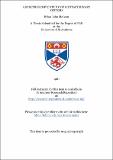Files in this item
A spectroscopic study of binary systems
Item metadata
| dc.contributor.advisor | Hilditch, R. W. | |
| dc.contributor.author | McLean, Brian John | |
| dc.coverage.spatial | 125 p. | en_US |
| dc.date.accessioned | 2018-06-25T08:18:59Z | |
| dc.date.available | 2018-06-25T08:18:59Z | |
| dc.date.issued | 1981 | |
| dc.identifier.uri | https://hdl.handle.net/10023/14503 | |
| dc.description.abstract | Spectroscopic observations of some of the brighter W Ursae Majoris type contact binaries in the northern hemisphere have been obtained at a medium dispersion of 20-30 Å/mm. A computer program has been developed to process and analyse these spectra using modem digital reduction techniques in order to obtain more accurate spectroscopic data for such systems. Radial velocity measurements have provided spectroscopic mass ratios which have been compared with the values derived from light curve synthesis. The improved mass ratios have removed the discrepancy which existed between the spectroscopic and photometric values in most of the systems observed. The application of spectrum deconvolution techniques has revealed an asymmetry in the structure of two W subclass systems shown by the variation in the strength of the primary components' spectral lines. Measurement, of the relative line strengths of the two components has provided further evidence for the presence of extensive magnetic starspots on the surface of the primary component of these systems. | en_US |
| dc.language.iso | en | en_US |
| dc.publisher | University of St Andrews | |
| dc.subject.lcc | QB903.M6 | |
| dc.subject.lcsh | Double stars | en |
| dc.title | A spectroscopic study of binary systems | en_US |
| dc.type | Thesis | en_US |
| dc.contributor.sponsor | Science Research Council (Great Britain) | en_US |
| dc.type.qualificationlevel | Doctoral | en_US |
| dc.type.qualificationname | PhD Doctor of Philosophy | en_US |
| dc.publisher.institution | The University of St Andrews | en_US |
This item appears in the following Collection(s)
Items in the St Andrews Research Repository are protected by copyright, with all rights reserved, unless otherwise indicated.

